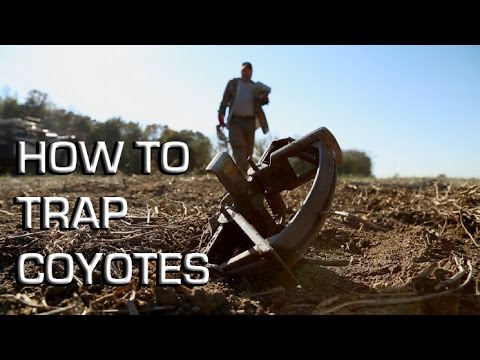
Contents
How to Trap Coyotes: Basic Gear and Skills
Encountering coyotes in outdoor spaces is a common experience for those who spend time outdoors. These clever scavengers and predators can be found in almost every U.S. state, adapting easily to various landscapes. When coyote populations become too high, starvation and disease can serve as natural population controls.
Humans can contribute to predator management through the practice of trapping. Modern trapping techniques have evolved significantly since the 1800s, with Best Management Practices ensuring ethical and safe trapping methods. This article will focus specifically on trapping coyotes and provide insights into the necessary gear and tactics.
Trapper Education
Prior to discussing the logistics of trapping coyotes, it is highly recommended to complete an in-person trapper education course. Although some states require this course for licensing, even in areas where it is not mandatory, attending the course can provide invaluable knowledge and hands-on experience from seasoned trappers. Gaining this expertise will significantly improve trapping success in the long run.
Coyote Trapping Gear
The essential equipment required for trapping coyotes includes a foothold trap, anchoring device, hammer, pan cover, sifter, and bait, scent, or lure. As trappers gain experience, they may find that certain items are unnecessary for specific scenarios. However, for beginners, it is advisable to include all of these items on their list.
Trap preferences vary based on budget and individual needs. The author personally recommends using fully modified traps designed for coyotes, prioritizing the animal’s comfort and overall humane trapping practices.
Fully modified traps feature offset jaws that prevent direct contact between metal surfaces, maintaining circulation within the trapped animal’s paw. Additionally, a center-swiveled base plate allows the animal to spin freely, reducing the risk of injury, while laminations increase the surface area against the paw, protecting fur and skin.
Satisfied customers have reported positive results with brands such as Bridger, Minnesota Brand, Duke, and K-9 X-treme JR. It is important to avoid purchasing closed-jaw, side-chained traps from general stores, as they are inadequate for trapping coyotes.
Anchoring Methods
Once an appropriate trap is selected, it is necessary to choose a reliable anchoring method to prevent trapped animals from escaping. There are several options available, including cross-staking rebar, earth anchor disposable stakes, and drags.
Cross-staking rebar involves inserting two long pieces of rebar into the ground in an X configuration. While this method offers reusability and simplicity, it can be physically demanding and inconvenient, particularly in frozen ground conditions.
Earth anchors, made of chain or cable, are effective disposable alternatives. Trappers can use a specialized driver to firmly insert the anchor into the ground. Once secured, the animal’s movement activates the anchor, preventing escape.

Another anchoring method involves using drags, which utilize a grapple-hooking system attached to a long chain. When properly rigged, a trapped coyote pulls the trap, chain, and grapple into nearby cover, minimizing the risk of visible traps and making trap resetting easier.
Trappers must ensure the strength and suitability of their chosen anchoring system, especially considering that trapped coyotes can exert up to 400 pounds of force on the trap. It is also essential to use a sturdy, heavy hammer for trap setting, as well as a pan cover to protect the trap’s functionality.
Attractants
Attractants play a crucial role in successfully trapping coyotes. Bait, urine, lure, or any scent that can entice coyotes to the trap location are all effective options. Numerous commercially available bait mixtures contain proven ingredients like beaver castor, skunk essence, and ground-up mice. However, homemade bait or simple scents like fox urine can also yield positive results.
Prepping Traps
Opinions vary among experienced trappers regarding trap preparation techniques. Some suggest spray painting traps to protect against rust, while others prefer dying and waxing traps for improved rust prevention and scent control. Regardless of the chosen method, it is crucial to ensure that traps are functioning correctly, attachment points are secure, and traps are tagged according to state regulations.
Making Sets
Choosing appropriate trapping locations is essential, and beginners can utilize trail cameras, fresh snowfall, and local animal behavior to identify suitable areas. Coyotes often mark intersections of trails and move along field edges deliberately, providing clear indicators of their presence.
The dirthole trap set is one of the most commonly used methods for trapping coyotes due to its simplicity and effectiveness. By burying the trap next to a scented hole in the ground, trappers can create an enticing setup for coyotes. Various modifications and variations of the dirthole set exist, allowing trappers to adapt to different conditions and challenges.
Successful trapping is largely dependent on setting traps on actual coyote signs, such as fresh tracks or scat. Trapping in areas based on outdated information or assumptions may result in prolonged waiting periods without any coyote activity.
Quick Tips for Coyote Trapping
These tips can improve trapping success, regardless of the location:
- Firmly bed traps to prevent curiosity-driven escape attempts.
- Focus on quality over quantity when setting traps.
- Obtain reliable information from credible sources such as books, trapper education classes, or reputable YouTube channels.
- Set traps away from high-traffic areas to avoid conflicts and non-target captures.
- Check traps regularly, preferably twice a day.
- Keep the trap setup simple and avoid excessive use of scents and lures.
- Be prepared for catching non-target animals and have an appropriate release plan.
- Follow state regulations regarding the dispatch and utilization of captured coyotes.
- Maximize the use of the animal by properly handling the fur, glands, urine, teeth, claws, and bones.
Understanding and implementing these tips will contribute to both trapping success and the sustainable management of coyote populations.

A skilled hunter, dedicated conservationist, and advocate for ethical practices. Respected in the hunting community, he balances human activity with environmental preservation.
